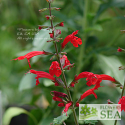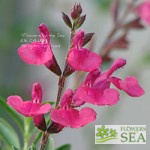(Crimson Sage) Abundant and long blooming, the bright pink to red tubular flowers of Salvia henryi attract hummingbirds and form a pretty contrast with fuzzy, silvery foliage. This is a long blooming sage that is made for gritty soils, such as sandy loam.
Crimson Sage often grows amid juniper and piñon trees and is native to rocky slopes and canyons in Arizona, New Mexico, Texas, and Northern Mexico. It can be a challenging to grow unless its planting conditions approximate the characteristics of these settings. Along with well-draining mineral soil, Salvia henryi needs full sun to partial shade and spare to average watering once established. It tolerates drought and heat, and would be ideal for planting in a Southwestern style rock gardens or xeriscape border. The flower color varies, and is influenced by the pH of the soil.
The square stems of this plant - also known as Henry's Sage - are typical of mint family (Laminaceae) plants, and its blossoms have split lower lips like so many Salvias. But Salvia henryi also has unusual traits, including the way its flowers march in opposing pairs up its stems and the lobed, oak-leaf shape of its leaves. Also, this isn't a fragrant sage.
East Coast botanist George Thurber (1821-1890) collected Salvia henryi somewhere along Southwestern New Mexico's Mimbres River on May 1, 1851 while serving with the U.S. Boundary Commission - a team of U.S. Army members, experts, and laborers that marked the border between America and Mexico.
Asa Gray (1810-1888), often referred to as the "father of American botany," classified Thurber's specimen and named it in honor of Irish physician Augustine Henry, who was famous for collecting medicinal plants in China. Gray published his description of Salvia henryi in 1872 in Proceedings of the American Academy of Arts and Sciences.
Limit 1 to a customer for this rare species.
Images copyright Frankie Coburn and Patrick Alexander under the Creative Commons Attribution-ShareAlike usage.


